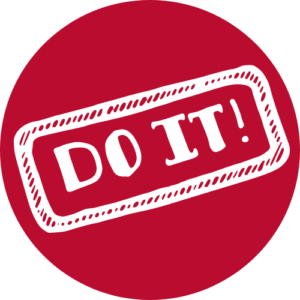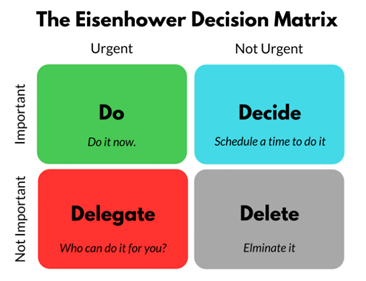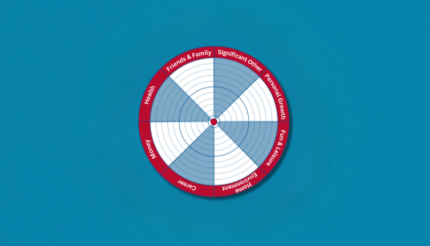Self-discipline is about doing what you know you need to do even when you don’t feel like it. It enables you to control your emotions and to act at the appropriate time in order to grow your business.
Here’s the thing; some days, emotions run high, and it can be hard to stay on top of everything. Self-discipline allows you to remain focused on the steps required to achieve your goals.
10 Strategies for Self-Discipline
The opposite of self-discipline is self-sabotage. The sooner you build the correct habits, the faster you can start working towards your goals and the sooner you will have the life you want.
Part of the process is clarifying what productivity means for you and then setting achievable goals for how much you can fit in a day, a week, or even down to the hour.
Work backwards from the Be – Do – Have formula: Define what it is that you want and identify the steps you will need to take to achieve it. Write down how many hours you can realistically work each day to achieve what you need to do.
With that in mind, let’s explore some of MY most effective strategies to build up self-discipline!
1 Create a daily list
 Before you finish your day, make a list of what needs to be done the next. Turn this productivity technique into a routine and gradually you will notice your productivity improve.
Before you finish your day, make a list of what needs to be done the next. Turn this productivity technique into a routine and gradually you will notice your productivity improve.
2 Know yourself
 Self-awareness is the key to instilling new habits. You need to be aware of your weaknesses by honestly writing down what distracts you from getting things done. Then create the environment that is most conducive to your productivity by removing those distractions.
Self-awareness is the key to instilling new habits. You need to be aware of your weaknesses by honestly writing down what distracts you from getting things done. Then create the environment that is most conducive to your productivity by removing those distractions.
3 Make plans
 Planning is essential to ensure that you make the most of your time. We all have different times of day when our level of productivity is at its peak. This is when you should schedule your most important tasks for the day. Be realistic too, so that it is more likely that you are setting yourself up for success … and don’t forget to allow for the odd cheat day!
Planning is essential to ensure that you make the most of your time. We all have different times of day when our level of productivity is at its peak. This is when you should schedule your most important tasks for the day. Be realistic too, so that it is more likely that you are setting yourself up for success … and don’t forget to allow for the odd cheat day!
4 Review your task list
 Often new, unscheduled tasks will appear out of nowhere and need to be allocated time. Review your task list and remove those items which are not essential to that day’s intended outcome. In this way, you will be able to manage your productivity effectively.
Often new, unscheduled tasks will appear out of nowhere and need to be allocated time. Review your task list and remove those items which are not essential to that day’s intended outcome. In this way, you will be able to manage your productivity effectively.
5 Act now
 Self-discipline is a commitment about acting in the present moment. If the process seems overwhelming, begin with small, manageable steps. Write a list of 25 important tasks, review and prioritise them, then pick the top 5 and start your journey.
Self-discipline is a commitment about acting in the present moment. If the process seems overwhelming, begin with small, manageable steps. Write a list of 25 important tasks, review and prioritise them, then pick the top 5 and start your journey.
6 Do six things every day
 Keeping your to-do list short and effective is the easiest way to ensure you get everything done without feeling overloaded. If your first piece of work is huge, break it down into six steps to keep it achievable. The challenge is to follow this methodology consistently until it becomes a habit.
Keeping your to-do list short and effective is the easiest way to ensure you get everything done without feeling overloaded. If your first piece of work is huge, break it down into six steps to keep it achievable. The challenge is to follow this methodology consistently until it becomes a habit.
7 Hold yourself accountable
 If you need a little encouragement on occasion, why not share your to do list with a colleague or friend? Feeling that you are accountable helps to focus your willpower and spurs you on to complete that list.
If you need a little encouragement on occasion, why not share your to do list with a colleague or friend? Feeling that you are accountable helps to focus your willpower and spurs you on to complete that list.
8 Keep a Default Diary
 Create a ‘default diary’ where you fill in the hours (or even half hour periods) of each day with what you need to be doing. Be specific. Schedule in the tasks that need to be done, so that you can ‘fall back’ on it at any time.
Create a ‘default diary’ where you fill in the hours (or even half hour periods) of each day with what you need to be doing. Be specific. Schedule in the tasks that need to be done, so that you can ‘fall back’ on it at any time.
Diary management is a very effective mechanism to keep your momentum going. It is an oft-neglected business tool which will help you keep control of your time. For instance, travel time has to be considered when scheduling meetings; ensure that meetings are kept crisp and to the point.
9 Have a Plan B
 Take time to think things through. Create different scenarios in case things don’t go to plan so that a backup plan can be implemented with minimum disruption to your objectives. According to Brad Sugars, Chairman and Founder of ActionCOACH, you should spend around 20% of your time planning and 80% of the time doing the work.
Take time to think things through. Create different scenarios in case things don’t go to plan so that a backup plan can be implemented with minimum disruption to your objectives. According to Brad Sugars, Chairman and Founder of ActionCOACH, you should spend around 20% of your time planning and 80% of the time doing the work.
10 Use the Eisenhower Matrix.
 The Eisenhower Matrix is a simple decision-making tool that divides tasks into four categories:
The Eisenhower Matrix is a simple decision-making tool that divides tasks into four categories:
-
- A – urgent and important
- B – important, not urgent
- C – urgent but not important
- D – not important, not urgent
Initially, you will be tempted to place most of your tasks into category A – ‘urgent and impor
tant’. Take time to review your list using the Eisenhower Matrix definitions and you will soon be able to start separating them into the other categories. In tim
e, as you get better at planning ahead, many of your A tasks will actually become B tasks.
Key outcomes of this process will be the action of delegation and, ultimately, deletion of those tasks that are distractions to meeting your ultimate objectives.
What’s Next?
You can’t be productive if you don’t know what you want to achieve, so go back to your vision board. If you still haven’t written down your goals, this is the perfect time to do so.
Try to come up with 25 things that need to be done to achieve your goals. As you build this list, remove distractions – things that slow you down and keep you from focusing on what truly matters for your success.
Pick six things to focus on to work towards the life you desire. Remember that building new habits happens gradually by using routines , such as writing your to-do list the evening before, diary management, practising accountability and, of course, remaining committed.
Don’t expect results overnight. Trust the process.






